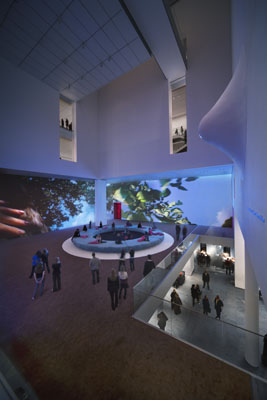« Features
Moving Matters - Pipilotti Rist @ MoMA
By Maja Horn
By most accounts the coming together of Swiss artist Pipilotti Rist and the Museum of Modern Art in New York, which commissioned her installation Pour Your Body Out (7354 Cubic Meters) for its massive second floor atrium, appears like a particularly happy marriage. Arguably, not since Chinese artist Cai Guo-Quiang’s spectacular installation of nine cars cascading down the Guggenheim rotunda (I Want to Believe Feb 22-May 28, 2008), has an artistic adaptation of a museum space in New York been this effectual. Yet, while Guo-Quiang’s exhibit was all explosions, gunpowder and force; Rist’s video installation, projected seamlessly on the atrium’s walls, evokes a flourishing natural world in which all things beginning with f… are in abundance: flowers, fluids, femininity. The vibrantly-colored, almost psychedelic-looking video loop with its hypnotizing instrumental soundtrack, the atrium’s carpeted floor and cushy circular couch for visitors to lie down on and take it all in, have been described as creating a womb-like setting-though some have also referred to a vagina. Whichever female body part one feels compelled to call upon, critics coincide in declaring that Pipilotti Rist effectively “feminized” the MoMA, an institution that some have critiqued for being anything but hospitable for female artists. (1)
What such enthusiastic claims attest to is how successfully Rist’s installation not only intervenes in, but decisively transforms, the imposing museum space. According to the scholar and critic Peggy Phelan, who has extensively written on Rist’s work, this is indeed one of the hallmarks of the artist’s oeuvre, which, since the late eighties, “has demonstrated an impressive technological fluency while pursuing a remarkably consistent emotional and aesthetic investigation of space.” (2) These assertions very much hold true for the MoMA’s commissioned piece; yet, Pour Your Body Out (7354 Cubic Meters) is more than just an investigation of space, it transforms and pours into the space, filling it up, all 7354 cubic meters of it. One might want to think back to Pipilotti Rist’s other large-scale intervention in New York City, the projection of her video Open my Glade on a huge Times Square electronic billboard in 2000. This video featured, in Rist’s own words, “a woman flattening her face against the screen as if she wanted to break out and come down into the Square.” (3) While in this earlier piece the screen was an insurmountable yet challenged boundary, this latest large-scale video installation in many ways breaks through the screen and with the help of sound and texture creates an all-encompassing, absorbent and compellingly-calming ambiance. This effect is born out by one of the unexpected results of the installation: as the New York Magazine reported with curiosity, the space has also become “the proprietor of New York’s most ludicrous day care … jam-packed with Bugaboos and Maclarens,” (4) and the accompanying scores of children and babies brought there by their caretakers.
This unforeseen transformation of the MoMA atrium into a kiddy wonderland attests both to the strengths and what I consider some of the faults of this work. While Rist clearly strikes her own chord in this museum space with technological savvy, creating a different kind of museum-going experience for its spectators, including its youngest ones, there is something a bit more risk-free and enervated about this work than some of the others through which she has come to be recognized. I am thinking, for example, of her contribution to the 47th Venice Biennale, Ever Is Over All (1997), a video piece in which a woman in a long-skirted blue dress walks down a street holding what appears to be an oversized long-stemmed flower that, unexpectedly, becomes her device to violently smash the windows of the parked cars she passes; this scene is accompanied by an overlapping video projection of a field of brightly colored flowers. The startling juxtaposition and scrambling of traditional associations that come with flowers, women, violence, and destruction, manifest in Phelan’s apt words a “daring exuberance of thinking outside the law, imagining a different relationship to property, to movement, to the criminal power of beauty itself.” (5)
In this MoMA installation, some of these same elements recur: vibrantly-colored flowers, a prominent female presence-albeit the urban landscape is here replaced with a lush natural world of grassy greens and flowing waters. This video piece also plays with and scrambles certain associations: a naked woman bites into an apple in a gleaming natural setting, inevitably evoking an image of the biblical Eva’s sinful and consequential act; the apple chewing woman then fades into an apple chewing pig, reinforcing thereby the association between femininity and being somehow soiled, an association that is reiterated with a shot of female hands caressing slimy and dirty earthworms, as well as with a scene of a woman with blood-stained underpants submerging into water, and lastly with an image of a floating female body with a trickle of blood slowly running down her chest. These scenes are set in, and alternate with, visually-stunning closeups of fields of flowers, apples, and trees that dwarf the viewer. The video thereby plays on age-old cultural codes that link femininity with nature and abundance, but also with “soiledness” and sin; yet these juxtapositions do not have a jarring or eye-opening effect, as do, for example, the associations created by Pipilotti Rist’s Ever Is Over All -they might make us squirm a bit, but they do not call upon us to re-imagine the relation between femininity and nature, the piece’s predominant themes.
It is not surprising that New York art critics have coincided in declaring the successful “feminization” of the MoMA through Rist’s work-Jerry Saltz even speaks of the “MoMA’s Sex Change”-while the word “feminism” has hardly come up in discussions of the piece. (6) The bright magenta colors, the images of flowers, fluids, and female nudity certainly scream “femininity,” but it is much less clear what else the piece has to say about it. One has to make room here for two caveats: Rist herself noted that the piece is not meant to have a clear narrative (unlike her forthcoming feature-length movie), but is intended to be more “poetic,” and the artist’s relation to feminism itself is not as obligatory as in the eyes of those who place her at the forefront of contemporary feminist art. Yet, while broaching femininity does not have to be at the explicit service of feminism, foregrounding it so forcefully imposes questions that the work itself neither fully asks nor answers. While this might be for poetic ends, most poets would reject the idea that a poem can afford to be less precise than a plot-driven narrative.
In the end, the narrative that Rist’s piece most successfully produces is one of scale: of dwarfing spectators in a monumental natural world that we like to think we dominate, and downscaling an imposing institution to a habitable human size. The emotional chord that she thereby masterfully plays upon and re-scrambles is that of awe. Rist replaces the venerable distance and respect that a museum normally asks us to bring towards its artworks with an awe that is brought about by an unaccustomed new closeness to the natural and usually less noteworthy. Arguably, thereby something much more far-reaching than a sex-change has taken place at the MoMA.
Notes
1. SALTZ, Jerry. “MoMA’s Sex Change: The Museum’s Pipilotti Rist Show Cheekily Feminizes A Bastion of Masculinity” in New York Magazine, January 5-12, 2009.
2. PHELAN, Peggy. “Opening Up Spaces within Spaces: The Expansive Art of Pipilotti Rist” in Pipilotti Rist, edited by Peggy Phelan, Hans Ulrich Obrist, Elisabeth Bronfen, Phaidon Press, 2001, P. 34.
3. RIST, Pipilotti. “Interview” with Hans Ulrich Obrist in Pipilotti Rist, edited by Peggy Phelan, Hans Ulrich Obrist, Elisabeth Bronfen, Phaidon Press, 2001, p. 23
4. HILL, Logan. “Because the Avant-Garde Is Our Playpen” in New York Magazine, Dec 14, 2008.
5. PHELAN, p. 62
6. Karen Rosenberg in her art review for the New York Times declares that this installation is “arguably the first project to humanize-and feminize-the atrium.” ROSENBERG, Karen. “Tiptoe by the Tulips (or Stretch by the Apples)” in New York Times, November 20, 2008.
Maja Horn: MA in Performance Studies (New York University), PhD in Romance Studies (Cornell University). Assistant Professor in Spanish and Latin American Cultures at Barnard College, New York.





































